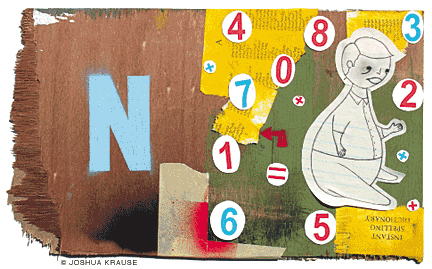
A teacher tells why the No Child Left Behind Act won’t work.
By Walt Gardner
Overwhelming numbers of public schools that have long been considered paragons of academic excellence are failing, creating anxiety and anger among parents who are bewildered by the trend.
The cause for their concern is the No Child Left Behind Act, the Bush administration’s basic educational initiative. The law contains a series of non-negotiable demands that create a sharp disparity between parental perception and governmental classification. Chief among these is that ever-increasing numbers of students must earn proficiency-level scores in order for their school to make “adequate yearly progress” over a 12-year, state-determined timeline. If any historically underserved subgroup, such as minority or handicapped students, does not meet this requirement, the entire school is regarded as failing, no matter how exemplary its other accomplishments may be. That means that awards in academic decathlons, debating, music, drama, or art count for naught. It also means that impressive college-acceptance data, the hitherto sine qua non of educational excellence, are irrelevant.
Instead, the sole basis for the school’s rating is performance on state-developed standardized tests in reading and math administered annually in grades three to eight and once again in high school. The law requires that 100 percent of students must be proficient by 2014, or their school will be taken over. Never mind that no country has ever been able to meet this goal. NCLB also requires all schools to have a “highly qualified” teacher in every classroom. Never mind the difficulty of recruiting teachers in such high-demand fields as science and math.
To complicate matters, no two states have to reach exactly the same standards to satisfy the law. That was the deal that states demanded in order to preserve control over their schools. Each state can determine how much a student needs to know to be proficient, how much yearly learning progress is sufficient and what qualities make for a highly qualified teacher. In Missouri, for example, a school can meet its annual progress goals if 19.4 percent of its students score proficient in reading. Yet, despite the low bar, 50.3 percent of schools in the state fell short of 2002-03 goals. In Ohio 40 percent must be proficient. There 21.6 percent missed their targets. In California, about 45 percent of the state’s 7,145 schools did not meet their test goals, and more than 1,500 are classified as failing for having fallen short of federal standards for two consecutive years. In Florida, only 408 of the state’s 3,177 public schools did well enough this year, meaning that many more will likely be failing next year. This hodgepodge of data is as confusing as it is useless for parents trying to judge their local schools. But NCLB insists on quantifying all educational outcomes in the dubious belief that only what can be measured is worthwhile.
If parents are somehow able to decode the available data and decide that they want to take their children out of the school they are enrolled in, they can request a transfer under NCLB. But time and again, they learn that no space is available in the better schools. In Chicago, more than 19,000 students asked to transfer, but the district had only about 1,000 places for them. New York reports that fewer than one-third of students who requested transfers actually got them. Other cities cite similar mismatches.
Even if space is found, the transition is not always smooth. Parents at schools that are required to accept transfer students worry about the impact of these students on the school. There’s good reason for that concern. A disproportionate number of students who flee failing schools under NCLB bring with them huge deficits in socialization, motivation, and intellectual development to class. As a result, they require an inordinate amount of time, energy, and money to educate. This unavoidably detracts from the educational program for existing students.
How we got into this situation is an instructive lesson in educational history. In 1965, Congress passed Title I of the Elementary and Secondary Education Act, which was the first major grant of federal dollars to low-income schools. But the money that was originally earmarked for inner-city and rural schools serving poor students soon became coveted by suburban districts and was diluted. To refocus on the worst-performing schools, George W. Bush instituted the concept of regular testing and higher standards that eventually became codified in the No Child Left Behind Act, signed into law in January 2002.
Supporters of the law adamantly maintain that only stringent standards and rigid enforcement of the law’s provisions can make schools accountable. They point to the long history of lax enforcement of previous legislation by the U.S. Department of Education. There’s truth to that charge, but in order for NCLB to work as intended, its demands have to be realistic, which they’re not, and they need to be adequately funded, which they aren’t. When the bill was written, $32 billion was initially authorized. President Bush has since whittled that amount down to $22.6 billion. The rancor has reached such a point that state legislators in Hawaii and in New England have proposed opting out of the federal program and losing the funding that now gives the government its leverage over states.
Whether more states follow is beside the point. As long as testing in its present form is retained anywhere, it contains the unavoidable potential to harm students under the guise of helping them. That’s because the tests in use today do not support teachers in their efforts to intervene in the learning process so that all students are able to reach their full potential. The tests fail on two counts in this regard. They are designed primarily to sort students out so that they can be compared with each other, even when this means including material that is highly unlikely to be taught in class. (That’s how the widely watched rankings of schools are created.) They don’t provide teachers with useful feedback until after the school year is over and students are gone. (By then, it’s too late to pinpoint weaknesses and take corrective action.)
Yet, despite these known pedagogical fatal flaws, teachers are under enormous pressure to narrow curriculum and instruction to what is likely to appear on the test in order to make themselves and their schools look good in the ratings game. Test scores then rise, leading some parents erroneously to conclude that their children’s schools are praiseworthy. But unknown to them, educational quality suffers in the process.
As the truth slowly emerges about how high-stakes testing is sucking the intellectual life out of the classroom, a nascent backlash is developing. Knowledgeable parents are beginning to demand authentic assessment of student learning, rather than tests that assess decontextualized knowledge. They want open-ended measures—such as student-created portfolios of literary essays, science projects, and art displays—that, they correctly maintain, more genuinely reflect what students really know. They call for student presentations that cut across strict subject matter lines, made before a panel of judges. This kind of performance-based assessment brings together skills and knowledge that in the end constitute the basis for the development of critical thinking and problem-solving ability. These are the qualities that make for success in the real world when today’s children will be tomorrow’s adults.
But more can be done. Parents need to work closely with their local schools to make their concerns known. They can get their opposition to high-stakes testing on the PTA agenda so that the subject can be openly discussed and pressure brought to bear on principals and politicians. They can write letters to local newspapers and form neighborhood committees to make their views known through presentations at chamber-of-commerce luncheons and at other service organizations.
How NCLB will eventually play out remains to be seen. The law that is beginning to generate strong resistance in some of the nation’s 90,000 public schools also has its supporters, who are equally committed. The result is a battle for the future of public education that carries with it far-reaching consequences not only for students but for the country as a whole.
Walt Gardner C’57 taught for 28 years in the Los Angeles Unified School District and was a lecturer in the UCLA Graduate School of Education. He writes frequently on education.




